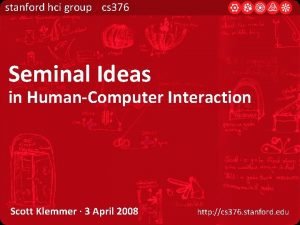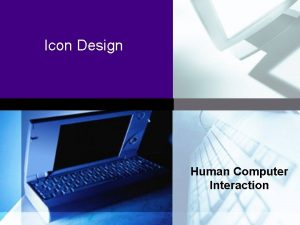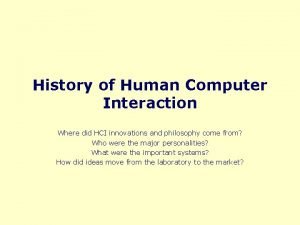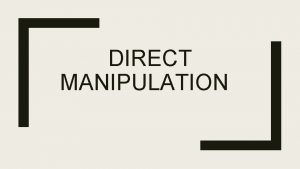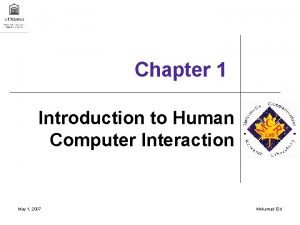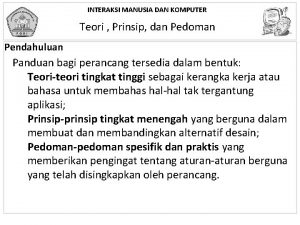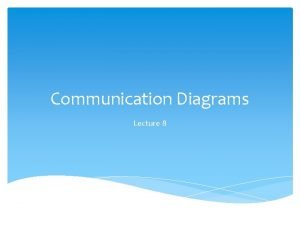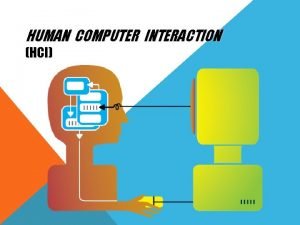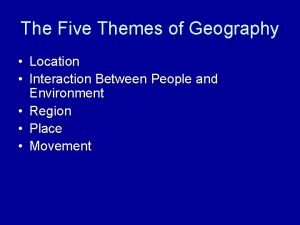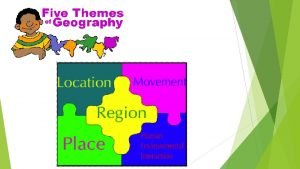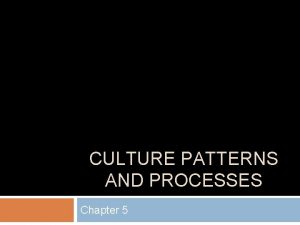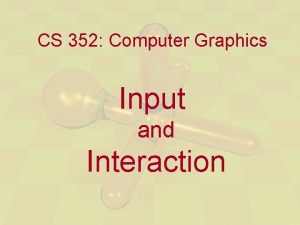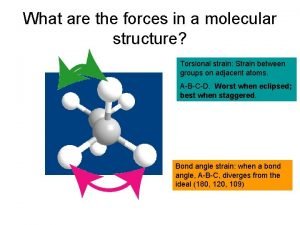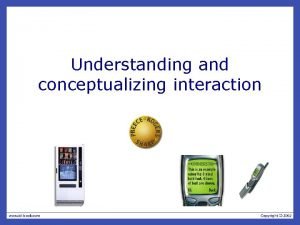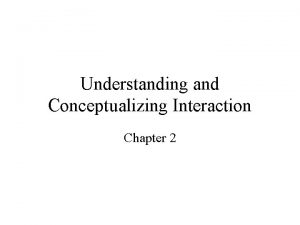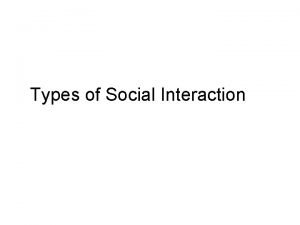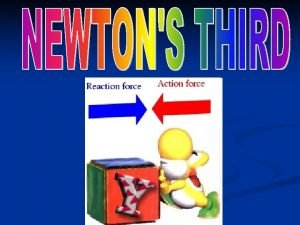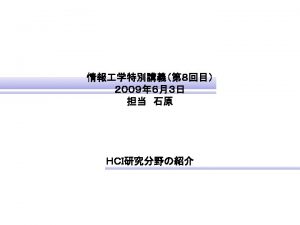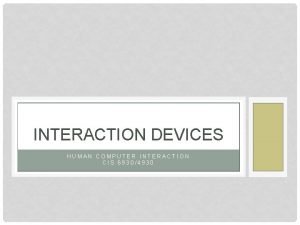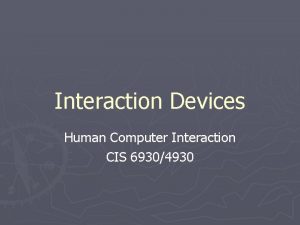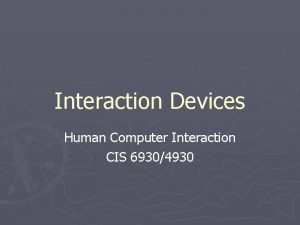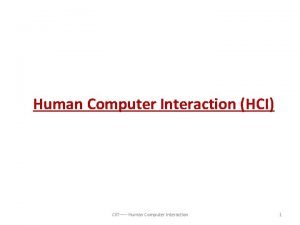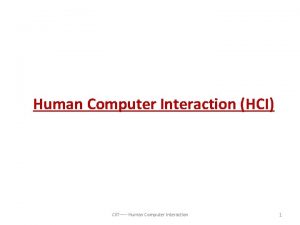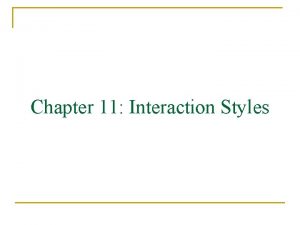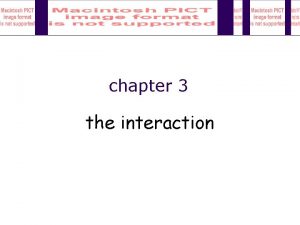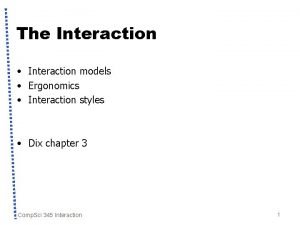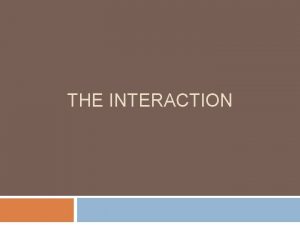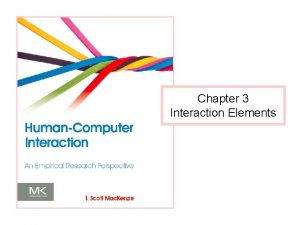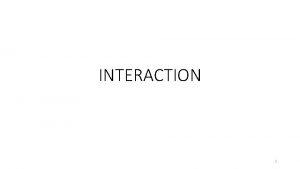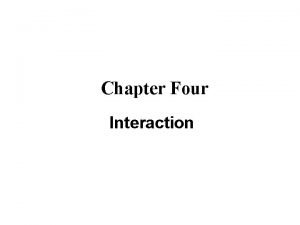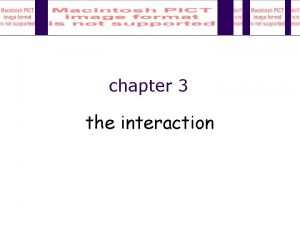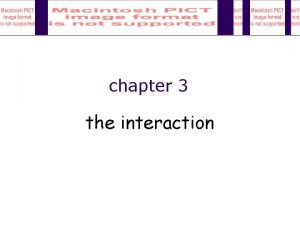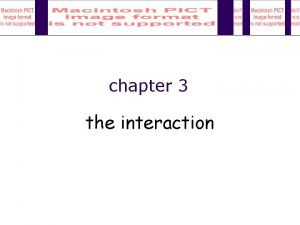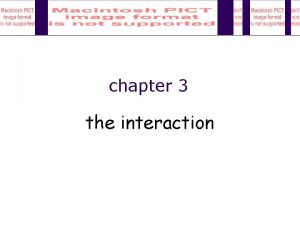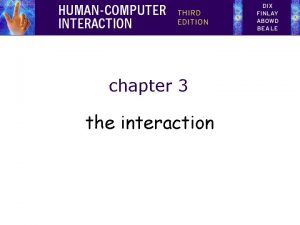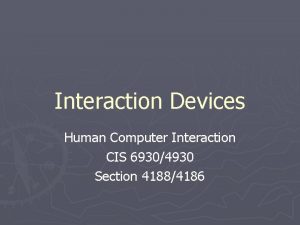Human Computer Interaction The Human The Computer a














































































- Slides: 78

Human Computer Interaction The Human

The Computer �a computer system is made up of various elements � each of these elements affects the interaction � input devices – text entry and pointing � output devices – screen (small&large), digital paper � virtual reality – special interaction and display devices � physical interaction – e. g. sound, haptic, bio-sensing � paper – as output (print) and input (scan) � memory – RAM & permanent media, capacity & access � processing – speed of processing, networks

Interacting with computers � to understand human–computer interaction … need to understand computers! what goes in and out devices, paper, sensors, etc. what can it do? memory, processing, networks

A ‘typical’ computer system � screen, or monitor, on which there are windows � keyboard � mouse/trackpad � variations desktop � laptop � PDA � � the devices dictate the styles of interaction that the system supports � If we use different devices, then the interface will support a different style of interaction

How many … � computers in your house? � hands up, … … none, 1, 2 , 3, more!! � computers in your pockets? are you thinking … … PC, laptop, PDA ? ?

How many computers … � in your house? � in your pockets? � PC � PDA � TV, � phone, VCR, DVD, Hi. Fi, cable/satellite TV � microwave, cooker, washing machine � central heating � security system � can you think of more? camera � smart card, card with magnetic strip? � electronic car key � USB memory � try your pockets and bags

Interactivity? � Long ago in a galaxy far away … batch processing punched card stacks or large data files prepared � long wait …. � line printer output � … and if it is not right … � � Now most computing is interactive rapid feedback � the user in control (most of the time) � doing rather than thinking … � � Is faster always better?

Richer interaction sensors and devices everywhere

text entry devices keyboards (QWERTY et al. ) chord keyboards, phone pads handwriting, speech

Keyboards � Most common text input device � Allows rapid entry of text by experienced users � Keypress closes connection, causing a character code to be sent � Usually connected by cable, but can be wireless

layout – QWERTY � Standardised � but layout … � non-alphanumeric keys are placed differently � accented symbols needed for different scripts � minor differences between UK and USA keyboards � QWERTY arrangement not optimal for typing – layout to prevent typewriters jamming! � Alternative designs allow faster typing but large social base of QWERTY typists produces reluctance to change.

QWERTY (ctd)

alternative keyboard layouts � Alphabetic keys arranged in alphabetic order � not faster for trained typists � not faster for beginners either! � � Dvorak common letters under dominant fingers � biased towards right hand � common combinations of letters alternate between hands � 10 -15% improvement in speed and reduction in fatigue � But - large social base of QWERTY typists produce market pressures not to change �

special keyboards � designs to reduce fatigue for RSI � Repetitive � for Strain Injuries one handed use � e. g. the Maltron left-handed keyboard

Chord keyboards � only a few keys - four or 5 � letters typed as combination of keypresses � compact size � – ideal for portable applications � short learning time – keypresses reflect letter shape � fast � – once you have trained � BUT - social resistance, plus fatigue after extended use � NEW – niche market for some wearables

phone pad and T 9 entry � use numeric keys with multiple presses 2–abc � 3 -def � 4 -ghi � 5 -jkl � � hello 6 -mno 7 -pqrs 8 -tuv 9 -wxyz = 4433555[pause]555666 � surprisingly fast! � T 9 predictive entry type as if single key for each letter � use dictionary to ‘guess’ the right word � hello = 43556 … � but 26 -> menu ‘am’ or ‘an’ �

Handwriting recognition � Text can be input into the computer, using a pen and a digesting tablet � natural interaction � Technical problems: capturing all useful information - stroke path, pressure, etc. in a natural manner � segmenting joined up writing into individual letters � interpreting individual letters � coping with different styles of handwriting � � Used in PDAs, and tablet computers … … leave the keyboard on the desk!

Speech recognition � Improving � Most rapidly successful when: � single user – initial training and learns peculiarities � limited vocabulary systems � Problems � external with noise interfering � imprecision of pronunciation � large vocabularies � different speakers

Numeric keypads � for entering numbers quickly: � calculator, PC keyboard � for telephones � not the same!! � ATM like phone 1 2 3 7 8 9 4 5 6 7 8 9 1 2 3 * 0 # 0 . = telephone calculator

positioning, pointing and drawing mouse, touchpad, trackballs, joysticks etc. touch screens, tablets, eyegaze, cursors

the Mouse � Handheld pointing device � very common � easy to use � Two characteristics � planar movement � buttons � (usually from 1 to 3 buttons on top, used for making a selection, indicating an option, or to initiate drawing etc. )

the mouse (ctd) � Mouse located on desktop requires physical space � no arm fatigue � � Relative movement only is detectable. � Movement of mouse moves screen cursor � Screen cursor oriented in (x, y) plane, mouse movement in (x, z) plane … �… an indirect manipulation device itself doesn’t obscure screen, is accurate and fast. � hand-eye coordination problems for novice users �

How does it work? � Two methods for detecting motion � Mechanical Ball on underside of mouse turns as mouse is moved � Rotates orthogonal potentiometers � Can be used on almost any flat surface � � Optical light emitting diode on underside of mouse � may use special grid-like pad or just on desk � less susceptible to dust and dirt � detects fluctuating alterations in reflected light intensity to calculate relative motion in (x, z) plane �

Even by foot … � some experiments with the footmouse � controlling mouse movement with feet … � not very common : -) � but foot controls are common elsewhere: � car pedals � sewing machine speed control � organ and piano pedals

Touchpad � small touch sensitive tablets � ‘stroke’ to move mouse pointer � used mainly in laptop computers � good � fast ‘acceleration’ settings important stroke � lots of pixels per inch moved � initial movement to the target � slow stroke � less pixels per inch � for accurate positioning

Trackball and thumbwheels � Trackball � ball is rotated inside static housing � like an upsdie down mouse! � relative motion moves cursor � indirect device, fairly accurate � separate buttons for picking � very fast for gaming � used in some portable and notebook computers. � Thumbwheels � for … accurate CAD – two dials for X-Y cursor position � for fast scrolling – single dial on mouse

Joystick and keyboard nipple � Joystick � indirect pressure of stick = velocity of movement � buttons for selection on top or on front like a trigger � often used for computer games aircraft controls and 3 D navigation � Keyboard � for nipple laptop computers � miniature joystick in the middle of the keyboard

Touch-sensitive screen � Detect the presence of finger or stylus on the screen. � � � Advantages: � � works by interrupting matrix of light beams, capacitance changes or ultrasonic reflections direct pointing device fast, and requires no specialised pointer good for menu selection suitable for use in hostile environment: clean and safe from damage. Disadvantages: � � finger can mark screen imprecise (finger is a fairly blunt instrument!) � � difficult to select small regions or perform accurate drawing lifting arm can be tiring

Stylus and light pen � Stylus � small pen-like pointer to draw directly on screen � may use touch sensitive surface or magnetic detection � used in PDA, tablets PCs and drawing tables � Light � now Pen rarely used � uses light from screen to detect location � BOTH � very … direct and obvious to use � but can obscure screen

Cursor keys � Four keys (up, down, left, right) on keyboard. � Very, very cheap, but slow. � Useful for not much more than basic motion for textediting tasks. � No standardised layout, but inverted “T”, most common

Discrete positioning controls � in phones, TV controls etc. � cursor pads or mini-joysticks � discrete left-right, up-down � mainly for menu selection

display devices bitmap screens (CRT & LCD) large & situated displays digital paper

bitmap displays � screen is vast number of coloured dots

resolution and colour depth � Resolution � number of pixels on screen (width x height) � e. g. � … used (inconsistently) for SVGA 1024 x 768, PDA perhaps 240 x 400 density of pixels (in pixels or dots per inch - dpi) � typically � Aspect between 72 and 96 dpi ration between width and height � 4: 3 for most screens, 16: 9 for wide-screen TV � � Colour depth: how many different colours for each pixel? � black/white or greys only � 256 from a pallete � 8 bits each for red/green/blue = millions of colours �

anti-aliasing � Jaggies � diagonal lines that have discontinuities in due to horizontal raster scan process. � Anti-aliasing � softens edges by using shades of line colour � also used for text

Cathode ray tube � Stream of electrons emitted from electron gun, focused and directed by magnetic fields, hit phosphor-coated screen which glows � used in TVs and computer monitors

Health hazards of CRT ! � X-rays: largely absorbed by screen (but not at rear!) � UV- and IR-radiation from phosphors: insignificant levels � Radio frequency emissions, plus ultrasound (~16 k. Hz) � Electrostatic field - leaks out through tube to user. Intensity dependant on distance and humidity. Can cause rashes. � Electromagnetic fields (50 Hz-0. 5 MHz). Create induction currents in conductive materials, including the human body. Two types of effects attributed to this: visual system - high incidence of cataracts in VDU operators, and concern over reproductive disorders (miscarriages and birth defects).

Health hints … � do not sit too close to the screen � do not use very small fonts � do not look at the screen for long periods without a break � do not place the screen directly in front of a bright window � work in well-lit surroundings � Take extra care if pregnant. but also posture, ergonomics, stress

Liquid crystal displays � Smaller, lighter, and … no radiation problems. � Found on PDAs, portables and notebooks, … and increasingly on desktop and even for home TV � also used in dedicted displays: digital watches, mobile phones, Hi. Fi controls � How it works … Top plate transparent and polarised, bottom plate reflecting. � Light passes through top plate and crystal, and reflects back to eye. � Voltage applied to crystal changes polarisation and hence colour � N. B. light reflected not emitted => less eye strain �

Hermes a situated display � small displays beside office doors � handwritten notes left using stylus � office owner reads notes using web interface small displays beside office doors handwritten notes left using stylus office owner reads notes using web interface

Digital paper � what? � thin flexible sheets � updated electronically � but retain display appearance cross section � how? � small spheres turned � or channels with coloured liquid and contrasting spheres � rapidly developing area

virtual reality and 3 D interaction positioning in 3 D space moving and grasping seeing 3 D (helmets and caves)

positioning in 3 D space � cockpit and virtual controls � steering � the wheels, knobs and dials … just like real! 3 D mouse � six-degrees � data glove � fibre � VR of movement: x, y, z + roll, pitch, yaw optics used to detect finger position helmets � detect � whole head motion and possibly eye gaze body tracking � accelerometers strapped to limbs or reflective dots and video processing

pitch, yaw and roll yaw pitch roll

3 D Mouse for 3 D Modelling

3 D displays � desktop VR � ordinary screen, mouse or keyboard control � perspective and motion give 3 D effect � seeing in 3 D � use stereoscopic vision � VR helmets � screen plus shuttered specs, etc. also see extra slides on 3 D vision

VR motion sickness � time delay � move head … lag … display moves � conflict: head movement vs. eyes � depth perception � headset gives different stereo distance � but all focused in same plane � conflict: eye angle vs. focus � conflicting � helps cues => sickness motivate improvements in technology

physical controls, sensors etc. special displays and gauges sound, touch, feel, smell physical controls environmental and bio-sensing

dedicated displays � analogue � dials, � digital � small representations: gauges, lights, etc. displays: LCD screens, LED lights, etc. � head-up � found displays in aircraft cockpits � show most important controls … depending on context

Sounds � beeps, � used bongs, clonks, whistles and whirrs for error indications � confirmation of actions e. g. keyclick

Touch, feel, smell � touch and feeling important � in games … vibration, force feedback � in simulation … feel of surgical instruments � called haptic devices � texture, smell, taste � current technology very limited

BMW i. Drive � for controlling menus � feel small ‘bumps’ for each item � makes it easier to select options by feel � uses haptic technology from Immersion Corp.

physical controls � specialist controls needed … � industrial controls, consumer products, etc. easy-clean smooth buttons large buttons multi-function control clear dials tiny buttons

Environment and bio-sensing � sensors all around us � car courtesy light – small switch on door � ultrasound detectors – security, washbasins � RFID security tags in shops � temperature, weight, location �… and even our own bodies … � iris scanners, body temperature, heart rate, galvanic skin response, blink rate

paper: printing and scanning print technology fonts, page description, WYSIWYG scanning, OCR

Printing � image made from small dots � allows � critical any character set or graphic to be printed, features: � resolution � size and spacing of the dots � measured in dots per inch (dpi) � speed � usually � cost!! measured in pages per minute

Types of dot-based printers � dot-matrix � use printers inked ribbon (like a typewriter � line of pins that can strike the ribbon, dotting the paper. � typical resolution 80 -120 dpi � ink-jet � tiny and bubble-jet printers blobs of ink sent from print head to paper � typically 300 dpi or better. � laser � like printer photocopier: dots of electrostatic charge deposited on drum, which picks up toner (black powder form of ink) rolled onto paper which is then fixed with heat � typically 600 dpi or better.

Printing in the workplace � shop tills � dot matrix � same print head used for several paper rolls � may also print cheques � thermal � special printers heat-sensitive paper � paper heated by pins makes a dot � poor quality, but simple & low maintenance � used in some fax machines

Fonts � Pitch � fixed-pitch � e. g. – every character has the same width Courier � variable-pitched � e. g. � Serif – some characters wider Times Roman – compare the ‘i’ and the “m” or Sans-serif � sans-serif � e. g. � serif � e. g. – square-ended strokes Helvetica – with splayed ends (such as) Times Roman or Palatino

Readability of text � lowercase � easy to read shape of words � UPPERCASE � better for individual letters and non-words e. g. flight numbers: BA 793 vs. ba 793 � serif fonts � helps your eye on long lines of printed text � but sans serif often better on screen

Screen and page � WYSIWYG � what you see is what you get � aim of word processing, etc. � but … � screen: 72 dpi, landscape image � print: 600+ dpi, portrait � can try to make them similar but never quite the same � so … need different designs, graphics etc, for screen and print

Scanners � Take paper and convert it into a bitmap � Two sorts of scanner � flat-bed: paper placed on a glass plate, whole page converted into bitmap � hand-held: scanner passed over paper, digitising strip typically 3 -4” wide � Shines light at paper and note intensity of reflection � colour � Typical or greyscale resolutions from 600– 2400 dpi

Optical character recognition � OCR converts bitmap back into text � different fonts � create problems for simple “template matching” algorithms � more complex systems segment text, decompose it into lines and arcs, and decipher characters that way � page format � columns, pictures, headers and footers

Paper-based interaction � paper � can be input too – OCR, scanning, etc. � Xerox � usually regarded as output only Paper. Works glyphs – small patterns of /\//\ � used to identify forms etc. � used with scanner and fax to control applications � more � recently papers micro printed - like wattermarks � identify � which sheet and where you are special ‘pen’ can read locations � know where they are writing

memory short term and long term speed, capacity, compression formats, access

Short-term Memory - RAM � Random access memory (RAM) � on silicon chips � 100 nano-second access time � usually volatile (lose information if power turned off) � data transferred at around 100 Mbytes/sec � Some non-volatile RAM used to store basic set-up information � Typical (old) desktop computers: 64 to 256 Mbytes RAM

Long-term Memory - disks � magnetic disks � floppy disks store around 1. 4 Mbytes � hard disks typically 40 Gbytes to 100 s of Gbytes access time ~10 ms, transfer rate 100 kbytes/s � optical � use disks lasers to read and sometimes write � more robust that magnetic media � CD-ROM - same technology as home audio, ~ 600 Mbytes � DVD - for AV applications, or very large files

Blurring boundaries � PDAs � often use RAM for their main memory � Flash-Memory � used in PDAs, cameras etc. � silicon based but persistent � plug-in USB devices for data transfer

speed and capacity � what do the numbers mean? � some sizes (all uncompressed) … � this book, text only ~ 320, 000 words, 2 Mb � the Bible ~ 4. 5 Mbytes � scanned page ~ 128 Mbytes � (11 x 8 � digital � (2– 4 � video inches, 1200 dpi, 8 bit greyscale) photo ~ 10 Mbytes mega pixels, 24 bit colour) ~ 10 Mbytes per second � (512 x 512, 12 bit colour, 25 frames per sec)

Compression � reduce amount of storage required � lossless � recover exact text or image – e. g. GIF, ZIP � look for commonalities: � text: AAAAABBBBBCCCC 10 A 5 B 8 C � video: compare successive frames and store change � lossy � recover something like original – e. g. JPEG, MP 3 � exploit perception � JPEG: lose rapid changes and some colour � MP 3: reduce accuracy of drowned out notes

Storage formats - text � ASCII - 7 -bit binary code for to each letter and character � UTF-8 - 8 -bit encoding of 16 bit character set � RTF (rich text format) - text plus formatting and layout information � SGML (standardized generalised markup language) - documents regarded as structured objects � XML (extended markup language) - simpler version of SGML for web applications

Storage formats - media � Images: � many storage formats : (Post. Script, GIFF, JPEG, TIFF, PICT, etc. ) � plus different compression techniques (to reduce their storage requirements) � Audio/Video � again lots of formats : (Quick. Time, MPEG, WAV, etc. ) � compression even more important � also ‘streaming’ formats for network delivery

processing and networks finite speed (but also Moore’s law) limits of interaction networked computing

Finite processing speed � Designers tend to assume fast processors, and make interfaces more and more complicated � But problems occur, because processing cannot keep up with all the tasks it needs to do cursor overshooting because system has buffered keypresses � icon wars - user clicks on icon, nothing happens, clicks on another, then system responds and windows fly everywhere � � Also problems if system is too fast - e. g. help screens may scroll through text much too rapidly to be read

Moore’s law � computers � 1965 get faster and faster! … � Gordon Moore, co-founder of Intel, noticed a pattern � processor speed doubles every 18 months � PC … 1987: 1. 5 Mhz, 2002: 1. 5 GHz � similar pattern for memory � but doubles every 12 months!! � hard disk … 1991: 20 Mbyte : 2002: 30 Gbyte � baby born today � record all sound and vision � by 70 all life’s memories stored in a grain of dust! /e 3/online/moores-law/

Limitations on interactive performance � Computation � Storage bound takes ages, causing frustration for the user channel bound � Bottleneck in transference of data from disk to memory � Graphics bound � Network capacity � Common bottleneck: updating displays requires a lot of effort - sometimes helped by adding a graphics coprocessor optimised to take on the burden � Many computers networked - shared resources and files, access to printers etc. - but interactive performance can be reduced by slow network speed

Networked computing � Networks allow access to … � large memory and processing � other people (groupware, email) � shared resources – esp. the web � Issues � network delays – slow feedback � conflicts - many people update data � unpredictability

The internet � history … � 1969: DARPANET US Do. D, 4 sites � 1971: 23; 1984: 1000; 1989: 10000 � common � TCP – Transmission Control protocol � lower � IP language (protocols): level, packets (like letters) between machines – Internet Protocol � reliable channel (like phone call) between programs on machines � email, HTTP, all build on top of these
 Stanford hci
Stanford hci Icon based logo
Icon based logo Paradigms of interaction in hci
Paradigms of interaction in hci Input output channels in hci
Input output channels in hci History of human computer interface
History of human computer interface Direct manipulation hci
Direct manipulation hci Hci chapter 1
Hci chapter 1 The future of human computer interaction
The future of human computer interaction Prinsip interaksi manusia dan komputer
Prinsip interaksi manusia dan komputer Interaction design syllabus
Interaction design syllabus Pengertian hci
Pengertian hci Alan dix
Alan dix Human computer interaction diagram
Human computer interaction diagram Ergonomics in human computer interaction
Ergonomics in human computer interaction Hci merupakan
Hci merupakan Hei geography definition
Hei geography definition Functional region
Functional region Portland absolute location
Portland absolute location Spatial interaction ap human geography
Spatial interaction ap human geography River nile map
River nile map Generalized map ap human geography
Generalized map ap human geography What is geography
What is geography Standard language definition ap human geography
Standard language definition ap human geography Perceptual region definition
Perceptual region definition Human environment interaction
Human environment interaction What is a functional region
What is a functional region Expansion diffusion def
Expansion diffusion def Rome human environment interaction
Rome human environment interaction Interaction in computer graphics
Interaction in computer graphics Hình ảnh bộ gõ cơ thể búng tay
Hình ảnh bộ gõ cơ thể búng tay Lp html
Lp html Bổ thể
Bổ thể Tỉ lệ cơ thể trẻ em
Tỉ lệ cơ thể trẻ em Chó sói
Chó sói Chụp tư thế worms-breton
Chụp tư thế worms-breton Chúa yêu trần thế
Chúa yêu trần thế Các môn thể thao bắt đầu bằng tiếng nhảy
Các môn thể thao bắt đầu bằng tiếng nhảy Thế nào là hệ số cao nhất
Thế nào là hệ số cao nhất Các châu lục và đại dương trên thế giới
Các châu lục và đại dương trên thế giới Công thức tính độ biến thiên đông lượng
Công thức tính độ biến thiên đông lượng Trời xanh đây là của chúng ta thể thơ
Trời xanh đây là của chúng ta thể thơ Mật thư anh em như thể tay chân
Mật thư anh em như thể tay chân 101012 bằng
101012 bằng độ dài liên kết
độ dài liên kết Các châu lục và đại dương trên thế giới
Các châu lục và đại dương trên thế giới Thơ thất ngôn tứ tuyệt đường luật
Thơ thất ngôn tứ tuyệt đường luật Quá trình desamine hóa có thể tạo ra
Quá trình desamine hóa có thể tạo ra Một số thể thơ truyền thống
Một số thể thơ truyền thống Bàn tay mà dây bẩn
Bàn tay mà dây bẩn Vẽ hình chiếu vuông góc của vật thể sau
Vẽ hình chiếu vuông góc của vật thể sau Thế nào là sự mỏi cơ
Thế nào là sự mỏi cơ đặc điểm cơ thể của người tối cổ
đặc điểm cơ thể của người tối cổ Thế nào là giọng cùng tên? *
Thế nào là giọng cùng tên? * Vẽ hình chiếu đứng bằng cạnh của vật thể
Vẽ hình chiếu đứng bằng cạnh của vật thể Tia chieu sa te
Tia chieu sa te Thẻ vin
Thẻ vin đại từ thay thế
đại từ thay thế điện thế nghỉ
điện thế nghỉ Tư thế ngồi viết
Tư thế ngồi viết Diễn thế sinh thái là
Diễn thế sinh thái là Các loại đột biến cấu trúc nhiễm sắc thể
Các loại đột biến cấu trúc nhiễm sắc thể Số nguyên tố là số gì
Số nguyên tố là số gì Tư thế ngồi viết
Tư thế ngồi viết Lời thề hippocrates
Lời thề hippocrates Thiếu nhi thế giới liên hoan
Thiếu nhi thế giới liên hoan ưu thế lai là gì
ưu thế lai là gì Hươu thường đẻ mỗi lứa mấy con
Hươu thường đẻ mỗi lứa mấy con Khi nào hổ con có thể sống độc lập
Khi nào hổ con có thể sống độc lập Sơ đồ cơ thể người
Sơ đồ cơ thể người Từ ngữ thể hiện lòng nhân hậu
Từ ngữ thể hiện lòng nhân hậu Thế nào là mạng điện lắp đặt kiểu nổi
Thế nào là mạng điện lắp đặt kiểu nổi Gauche interaction in chair conformation
Gauche interaction in chair conformation Forrester real time interaction management
Forrester real time interaction management Total physical interaction
Total physical interaction What is problem space in hci
What is problem space in hci Hci conceptual model
Hci conceptual model Understanding and conceptualizing interaction
Understanding and conceptualizing interaction Conflict interaction examples
Conflict interaction examples Law of interaction
Law of interaction
